
Donato di Niccolò di Betto Bardi, known mononymously as Donatello, was an Italian sculptor of the Renaissance period. Born in Florence, he studied classical sculpture and used his knowledge to develop an Early Renaissance style of sculpture. He spent time in other cities, where he worked on commissions and taught others; his periods in Rome, Padua, and Siena introduced to other parts of Italy the techniques he had developed in the course of a long and productive career. His David was the first freestanding nude male sculpture since antiquity; like much of his work it was commissioned by the Medici family.

Lorenzo Ghiberti, born Lorenzo di Bartolo, was an Italian Renaissance sculptor from Florence, a key figure in the Early Renaissance, best known as the creator of two sets of bronze doors of the Florence Baptistery, the later one called by Michelangelo the Gates of Paradise. Trained as a goldsmith and sculptor, he established an important workshop for sculpture in metal. His book of Commentarii contains important writing on art, as well as what may be the earliest surviving autobiography by any artist.

Jacopo della Quercia, also known as Jacopo di Pietro d'Agnolo di Guarnieri, was an Italian sculptor of the Renaissance, a contemporary of Brunelleschi, Ghiberti and Donatello. He is considered a precursor of Michelangelo.

Ambrogio Lorenzetti or Ambruogio Laurati was an Italian painter of the Sienese school. He was active from approximately 1317 to 1348. He painted The Allegory of Good and Bad Government in the Sala dei Nove in Siena's Palazzo Pubblico. His elder brother was the painter Pietro Lorenzetti.
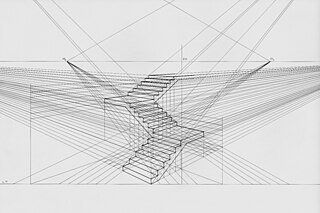
Linear or point-projection perspective is one of two types of graphical projection perspective in the graphic arts; the other is parallel projection. Linear perspective is an approximate representation, generally on a flat surface, of an image as it is seen by the eye. Perspective drawing is useful for representing a three-dimensional scene in a two-dimensional medium, like paper. It is based on the optical fact that for a person an object looks N times (linearly) smaller if it has been moved N times further from the eye than the original distance was.
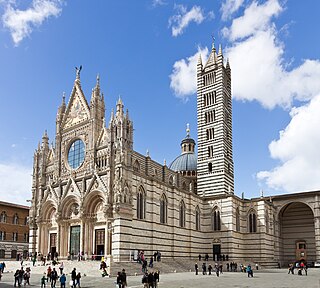
Siena Cathedral is a medieval church in Siena, Italy, dedicated from its earliest days as a Roman Catholic Marian church, and now dedicated to the Assumption of Mary.
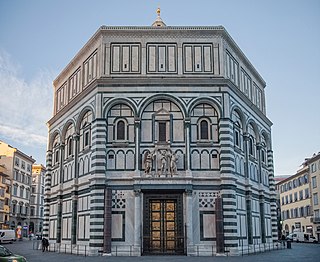
The Florence Baptistery, also known as the Baptistery of Saint John, is a religious building in Florence, Italy. Dedicated to the patron saint of the city, John the Baptist, it has been a focus of religious, civic, and artistic life since its completion. The octagonal baptistery stands in both the Piazza del Duomo and the Piazza San Giovanni, between Florence Cathedral and the Archbishop's Palace.

The Collegiata di Santa Maria Assunta or Duomo di San Gimignano is a Roman Catholic collegiate church and minor basilica in San Gimignano, in Tuscany in central Italy. It contains important cycles of Renaissance frescoes by artists including Domenico Ghirlandaio, Benozzo Gozzoli, Taddeo di Bartolo, Lippo Memmi and Bartolo di Fredi. It falls within the UNESCO World Heritage Site of the "Historic Centre of San Gimignano", with its frescoes being described by UNESCO as "works of outstanding beauty".

Domenico di Bartolo, born in Asciano, Siena, was a Sienese painter of the early Renaissance period. In the Lives of the Most Excellent Painters, Sculptors, and Architects, Giorgio Vasari says that Domenico was the nephew of Taddeo di Bartolo. Influenced by the new Florentine style of painting, Domenico di Bartolo was the only Sienese painter of his time to receive commissions from clients in Florence. In Siena, he was employed by Lorenzo di Pietro, to help execute the fresco The Care of the Sick, in the Pilgrim's Hall of the Hospital of Santa Maria della Scala.

Giotto's Campanile is a free-standing campanile that is part of the complex of buildings that make up Florence Cathedral on the Piazza del Duomo in Florence, Italy.
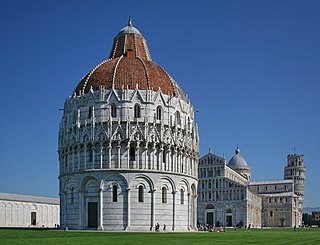
The Pisa Baptistery of St. John is a Roman Catholic ecclesiastical building in Pisa, Italy. Construction started in 1152 to replace an older baptistery, and when it was completed in 1363, it became the second building, in chronological order, in the Piazza dei Miracoli, near the Duomo di Pisa and the cathedral's free-standing campanile, the famous Leaning Tower of Pisa. The baptistery was designed by Diotisalvi, whose signature can be read on two pillars inside the building, with the date 1153.
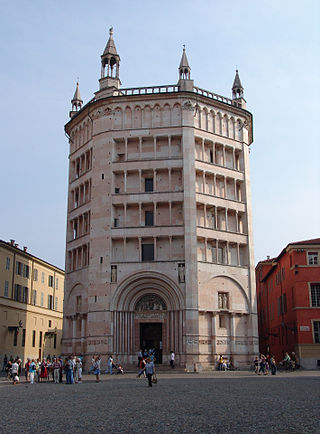
The Baptistery of Parma is a religious edifice in Parma, northern Italy. Architecturally, the baptistery of Parma Cathedral marks a transition between the Romanesque and Gothic styles, and it is considered to be among the most important Medieval monuments in Europe.

Florentine painting or the Florentine school refers to artists in, from, or influenced by the naturalistic style developed in Florence in the 14th century, largely through the efforts of Giotto di Bondone, and in the 15th century the leading school of Western painting. Some of the best known painters of the earlier Florentine School are Fra Angelico, Botticelli, Filippo Lippi, the Ghirlandaio family, Masolino, and Masaccio.
The decade of the 1420s in art involved some significant events.

The Tomb of Antipope John XXIII is the marble-and-bronze tomb monument of Antipope John XXIII, created by Donatello and Michelozzo for the Florence Baptistry adjacent to the Duomo. It was commissioned by the executors of Cossa's will after his death on December 22, 1419 and completed during the 1420s, establishing it as one of the early landmarks of Renaissance Florence. According to Ferdinand Gregorovius, the tomb is "at once the sepulchre of the Great Schism in the church and the last papal tomb which is outside Rome itself".

The Battistero di San Giovanni is a religious building in Siena, Italy. It is in the square with the same name, near the final spans of the choir of the city's cathedral.

The Museo dell'Opera del Duomo in Florence, Italy is a museum containing many of the original works of art created for Florence Cathedral, including the adjacent Florence Baptistery and Giotto's Campanile. Most of the exterior sculptures have been removed from these cathedral buildings, usually replaced by replica pieces, with the museum conserving the originals.
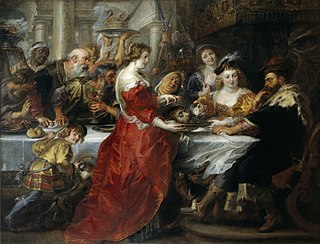
The Feast of Herod refers to the episode in the Gospels following the Beheading of St. John the Baptist, when Salome presents his head to her parents. The account in the Book of Mark describes Herod Antipas holding a banquet on his birthday for his high officials and military commanders, and leading men of Galilee. At this banquet, Herod's daughter dances before Herod, who is pleased and offers her anything she asks for in return. The girl asks her mother what she should request, and she is told to demand the head of John the Baptist. Reluctantly, Herod orders the beheading of John, and John's head is delivered to her, at her request, "on a platter."

Stiacciato (Tuscan) or schiacciato is a technique where a sculptor creates a very shallow relief sculpture with carving only millimetres deep. The rilievo stiacciato is primarily associated with Donatello (1386–1466).

Italian Renaissance sculpture was an important part of the art of the Italian Renaissance, in the early stages arguably representing the leading edge. The example of Ancient Roman sculpture hung very heavily over it, both in terms of style and the uses to which sculpture was put. In complete contrast to painting, there were many surviving Roman sculptures around Italy, above all in Rome, and new ones were being excavated all the time, and keenly collected. Apart from a handful of major figures, especially Michelangelo and Donatello, it is today less well-known than Italian Renaissance painting, but this was not the case at the time.



















